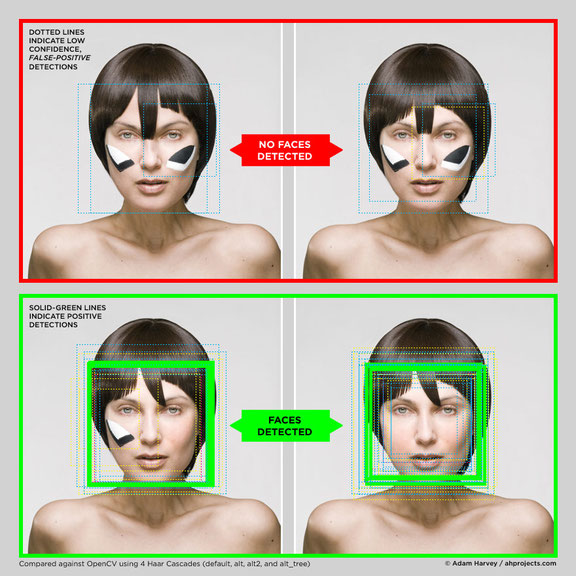Issue 1/2013 - Net section
Portraits of the XXI Century
Representations and Misrepresentations of Face and Artistic Responses
Introduction
The appearance of our individual faces in other peoples’ screens is now quotidian. This occurs through everyday tagging, Google searches, indexing and random selection of „known people“ through profile pictures in social media etc. Personal profiles lie within bureaucratic archives, are held in passport and ID records and captured, often trivially, in the documentation of everyday movements by surveillance cameras. The concept of the digital portrait is also held in question. Almost daily new techniques are noted with rapid exposure on online networks producing a serious investigation into concepts of the coherent or cohesive self and production of the image or self –image. A mass digitalization of portraits is coupled with increasingly ubiquitous retouching software tools, many specialized in retouching of faces and portraits. These are digitally shaping a visual field which relates closely to a specific area of our brains: an area of the temporal lobe dedicated to the recognition of faces. With the dynamic combination of multiplication of our digitized faces with extreme simplicity of manipulation, artworks and media interventions are being created to intrinsically anomalous effect.
[b]Face tracking software[/b]
CCTV cameras 1 are mushrooming throughout the developed world. In the UK alone there are an estimated 1.85 million. The resistance by artists to forms of visual manipulation through ironic performances can be symbolically dated back to the early plays of Surveillance Camera Players 2 and also to experiments with private CCTV in the 1970s. As technologies evolve, new processes and approaches have emerged. One project materialised in the form of a blog called „Nick Clegg Looking Algorithmically Sad“ 3 which deals with software and public figures. The author posts analysis of public pictures and TV screenshots of British Deputy PM, Nick Clegg, showing ‚scientifically ’ how his profile can be analysed as „sad“ most of the time. Others among a new generation of artists have learnt to camouflage their persona in order to defend their last bit of public privacy. Adam Harvey's CV Dazzle 4 is a glaring example of human adaptation to the logic of the machine. The artists developed a series of fashionable camouflages that, in fact, are successfully confusing face recognition algorithms, brilliantly transforming digital visual „noise“ into specific makeup or hairstyling design with a post –punk aesthetic and radical changes of proportions and spaces between elements on people faces to defy any face recognition software. Martin Backes' Pixelhead 5 proceeds from a perspective which is simultaneously similar and quite different. It is a pixelated mask made from elastic fabric superficially similar to urban guerrilla, but which elegantly defeats CCTV software, being made from the same colour palette as faces and unrecognizable once recorded by cameras. Both the above mentioned artworks are elaborating on machinic perception of faces, and „construction“ of a biometric identity. Julian Wolkenstein's Echoism.org 6 is instead based on machine –induced narcissism. The website is in fact a platform where people can upload their own portraits and explore symmetrical perfection, through a simple splitting and mirroring technique. The theory (or as the artist dismissed it „the myth“) that we see beauty in symmetry and so people with symmetrical faces are more „attractive“ is applied here literally. Moreover the obsession of self –representation sublimated in Facebook has been the place where Rina Dweck's Project Face took shape 7. She posted a photo of herself everyday for an entire year, quoting Cindy Sherman as inspiration. Her well conceived photos show a wide range of different aesthetics and cause viewers to wonder if photo manipulation is indeed present. Has digital manipulation of faces reached the stage where even documentary portraits can now be questioned? (cf the drama in Lalage Snow's We Are The Not Dead series about British soldiers before, during, and after their deployment in Afghanistan 8.) Is manipulation so familiar that we are now anaesthetized to the signs of pain on the triptych of soldiers' faces, possibly even unconsciously dismissing them as enhanced by software processes, if not plainly retouched?
[b]Recognition, the drug of the nation[/b]
The portrait’s function has been to represent an identity through its somatic traits. Tracking those traits we've been able to analyse family photographs as well as celebrity lives. Sophisticated techniques of „identity tracking“ are the latest toys for state and commercial tracking. Although Facebook turned off facial recognition in Europe, following an EU investigation, 9 this technology is completely ubiquitous, being a standard feature in average smartphones' cameras as well as in photo retouching software. The latest trends in industry show how face recognition is being conceived as a plain marketing tool. NEC has developed a marketing service that utilizes facial recognition technology to estimate the age and gender of customers, and accumulates the data, along with the dates and times that customers visit stores. 10 The demonstrative video used by the company recalls ( in a sinister way) the celebrated video artwork The Catalogue (by Chris Oakley) 11 which in 2004 successfully inoculated the fear of total surveillance and recognition in shopping malls. Identification of people was shown as more and more detailed and intimate as the video progressed, with persons quickly identified as soon as they entered the mall. More than „visionary“ or „predictive“ might we more accurately now suggest that these artworks can be seen as „industrial research and redevelopment“? With the new tools and techniques for observation and witnessing which are now characteristic of 21st century living, visual artists skilled in digital techniques find new contexts for exercise of radical lines of ethical enquiry into privacy, the public sphere and the idea of the individual.
1 http://www.independent.co.uk/news/uk/crime/new-hd-cctv-puts-human-rights-at-risk-8194844.html
2 http://www.notbored.org/the-scp.html
3 http://nickclegglookingalgosad.tumblr.com/
4 http://ahprojects.com/projects/cv-dazzle
5 http://www.martinbackes.com/pixelhead-limited-edition/
6 http://echoism.org/
7 http://rinadweck.com/projectface.html
8 http://www.mymodernmet.com/profiles/blogs/lalage-snow-we-are-the-not-dead
9 http://techcrunch.com/2012/09/21/facebook-turns-off-facial-recognition-in-the-eu-gets-the-all-clear-from-irelands-data-protection-commissioner-on-its-review/
10 http://www.diginfo.tv/v/12-0209-r-en.php
11 http://www.chrisoakley.com/the-catalogue
